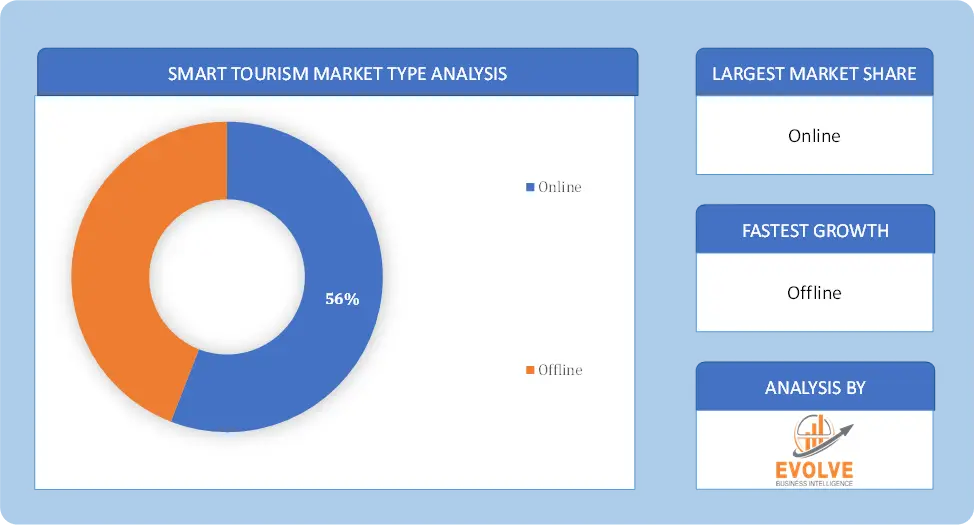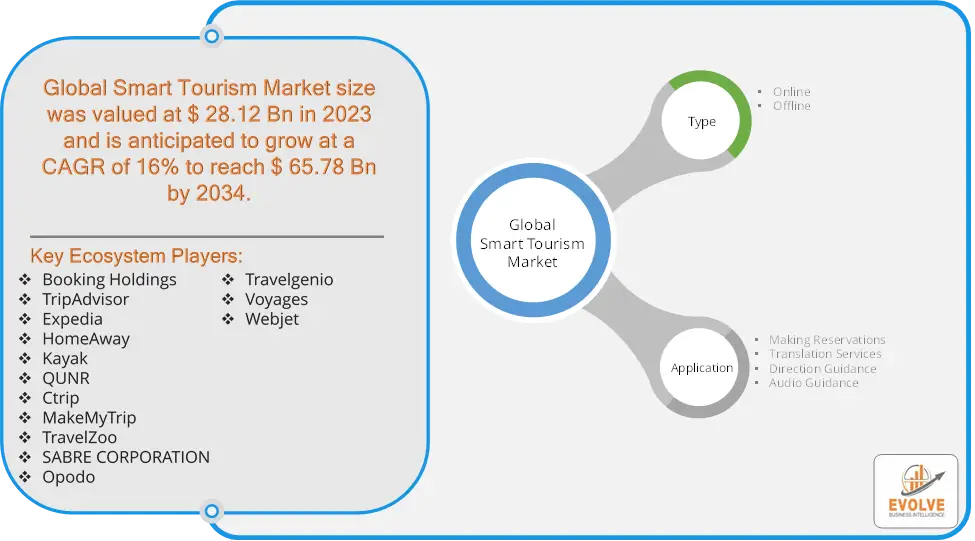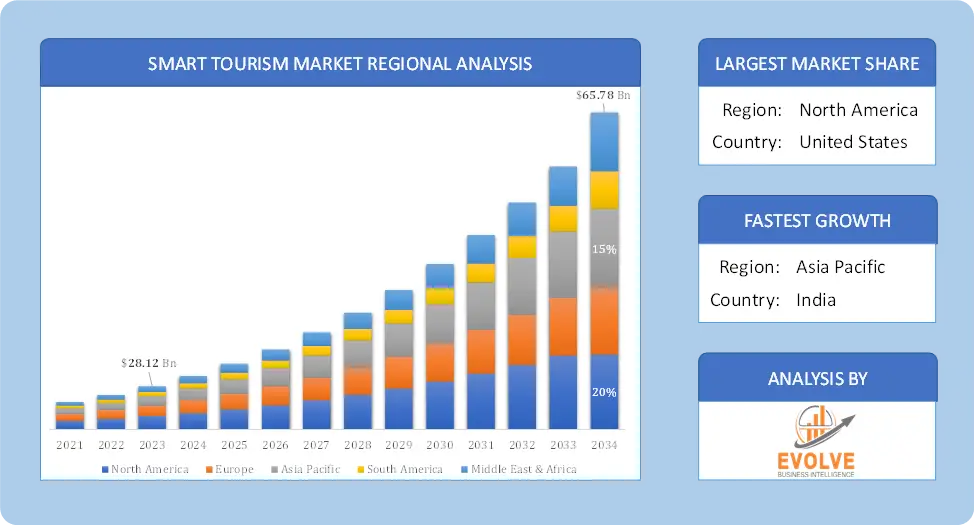Global Smart Tourism Market Analysis and Global Forecast 2021-2034
₹115,370.00 – ₹458,160.00Price range: ₹115,370.00 through ₹458,160.00
Global Smart Tourism Market Research Report: Information Type (Online and Offline), By Application (Making Reservations, Translation Services, Direction Guidance, Audio Guidance), and by Region — Forecast till 2034
Page: 140
Global Smart Tourism Market Overview
The Global Smart Tourism Market size accounted for USD 28.12 Billion in 2023 and is estimated to account for 29.55 Billion in 2024. The Market is expected to reach USD 65.78 Billion by 2034 growing at a compound annual growth rate (CAGR) of 16% from 2024 to 2034. Smart Tourism is an important component of Smart Cities and capitalizes on attracting tourists from all around the world to help expand tourism activity. Not only can it help with attracting more tourists but it also opens up new opportunities. Smart Tourism is focused on cutting-edge applications of communication and technology to emerging innovative tools and models for promoting tourism. The goal is to provide personalized communication and real-time information that allow tourists to make well-informed decisions when it comes to traveling.
Global Smart Tourism Market Synopsis
 Global Smart Tourism Market Dynamics
Global Smart Tourism Market Dynamics
The major factors that have impacted the growth of Global Smart Tourism are as follows:
Drivers:
Ø Increasing Popularity of Smart Infrastructure
New technologies are being used to enhance online travel booking websites, with a focus on multiple functionalities. Some of these services include location tracking, payment gateways, and more. Additional features make it easier to communicate and have a personalized experience, which is increasing the adoption of smart tourism. The increasing adoption of smart devices including phones and laptops supports the demand for smart tourism mobile applications.
Restraint:
- Perception of Lower Quality
The primary challenges facing the smart tourism industry today are keeping up with the changes in technology, ensuring a safe and secure environment for visitors, and the need for more robust data and analytics. . The tourism industry is faced with numerous competing streams of information, but the data that is most relevant to planning, marketing, and operational decisions comes from a variety of sources. The size, frequency, and intensity of tourism events can all impact a destination’s infrastructure needs, congestion, and air quality. Locations also face challenges in identity theft, cybercrime, and terrorism as they become more popular. The key to managing the potential risks associated with tourism is to ensure that appropriate and sufficient policies, regulations, legislation, and enforcement mechanisms are in place at the national and international levels to protect both visitors and the host country.
Opportunity:
- The emergence of Smart Cities
The market for smart tourism is becoming increasingly popular as more people are being convinced of the importance of these technologies both in determining what tourist experience they should have and how they should be operated. The rise of smart cities, thanks to a more sustainable approach to urban planning, has made the hotel and tourism industry evolve positively. Intelligent solutions such as Smart Tourism Market, which uses IoT technology to create “smart” services for the touristic experience and operation, are opening up new possibilities for the hospitality business. As more and more smart cities are being built, the Global Smart Tourism Market is expected to grow and contribute significantly to the worldwide market.
Global Smart Tourism Segment Overview
By Type
 Based on the Type, the Smart Tourism market is segmented based on Online and Offline Offerings. The Online segment is anticipated to account for the large market share because this is due to the significant advancement in technology and smart infrastructure. The online offering type allows tourists to explore mobile and internet applications’ smart tourism features. Advancements in online platforms offer features like GPS, payment gateways, reservations, and other functions that are expected to enhance the personalized experience for tourists.
Based on the Type, the Smart Tourism market is segmented based on Online and Offline Offerings. The Online segment is anticipated to account for the large market share because this is due to the significant advancement in technology and smart infrastructure. The online offering type allows tourists to explore mobile and internet applications’ smart tourism features. Advancements in online platforms offer features like GPS, payment gateways, reservations, and other functions that are expected to enhance the personalized experience for tourists.
By Application
Based on Industry, the global Smart Tourism market has been divided into Making Reservations, Translation Services, Direction Guidance, and Audio Guidance. The Direction Guidance is expected to hold the largest market share. This helps tourists to know where exactly they are headed and it’s also a time-consuming feature for avoiding any type of misguiding.
Global Smart Tourism Market Regional Analysis
Based on region, the Global Smart Tourism market has been divided into North America, Europe, Asia-Pacific, the Middle East & Africa, and Latin America. North America is projected to dominate the use of the Global Smart Tourism market followed by the Asia-Pacific and Europe regions.
 Global Smart Tourism North America Market
Global Smart Tourism North America Market
The North American region is projected to dominate the smart tourism market during the forecast period. Initiatives such as those taken by various countries in this region to develop strong technological infrastructure will steer demand for smart tourism solutions in this region. This has led to an increase in the number of visits by tourists across major cities in Canada and the US, which has increased the demand for smart tourism solutions among tourists through their country’s digital platforms. These factors point to substantial growth in the North American market resulting from evolving benefits over the next few years.
Global Smart Tourism Asia-Pacific Market
Latin American regions are expected to have the highest rate of CAGR in terms of Smart Tourism due to more users opting for technology-driven travel services such as online hotel room booking, online ticket booking for tourist attractions, etc. Further, the number of international tourists across Latin America is projected to increase over the next few years; this should result in a rise in demand for tourist guides and a consequent increase in the growth of that Latin American market.
Competitive Landscape
The Global Smart Tourism market is highly competitive, with numerous players offering a wide range of software solutions. The competitive landscape is characterized by the presence of established companies, as well as emerging startups and niche players. To increase their market position and attract a wide consumer base, the businesses are employing various strategies, such as Type launches, and strategic alliances.
Prominent Players:
- Booking Holdings
- TripAdvisor
- Expedia
- HomeAway
- Kayak
- QUNR
- Ctrip
- MakeMyTrip
- TravelZoo
- SABRE CORPORATION
- Opodo
- Travelgenio
- Voyages
- Webjet
Key Development
In October 2020, Vrbo partnered with NoiseAware LLC to give access to noise monitoring solutions and visitor restriction services for the management of their properties. The solution is often helpful in avoiding and removing unruly visitors, which can help prevent damage to private property.
Scope of the Report
Global Smart Tourism Market, by Type
- Online
- Offline
Global Smart Tourism Market, by Application
- Making Reservations
- Translation Services
- Direction Guidance
- Audio Guidance
Global Smart Tourism Market, by Region
- North America
- US
- Canada
- Mexico
- Europe
- UK
- Germany
- France
- Italy
- Spain
- Benelux
- Nordic
- Rest of Europe
- Asia Pacific
- China
- Japan
- South Korea
- Indonesia
- Austalia
- Malaysia
- India
- Rest of Asia Pacific
- South America
- Brazil
- Argentina
- Rest of South America
- Middle East & Africa
- Saudi Arabia
- UAE
- Egypt
- South Africa
- Rest of Middle East & Africa
| Parameters | Indicators |
|---|---|
| Market Size | 2033: $65.78 Billion |
| CAGR | 16% CAGR (2023-2033) |
| Base year | 2022 |
| Forecast Period | 2023-2033 |
| Historical Data | 2021 |
| Report Coverage | Revenue Forecast, Competitive Landscape, Growth Factors, and Trends |
| Key Segmentations | Type, Application |
| Geographies Covered | North America, Europe, Asia-Pacific, Latin America, Middle East, Africa |
| Key Vendors | Booking Holdings, TripAdvisor, Expedia, HomeAway, Kayak, QUNR, Ctrip, MakeMyTrip, TravelZoo, SABRE CORPORATION, Opodo, Travelgenio, Voyages, Webjet and com |
| Key Market Opportunities | • The emergence of Smart Cities |
| Key Market Drivers | • Increasing Popularity of Smart Infrastructure |
REPORT CONTENT BRIEF:
- High-level analysis of the current and future Global Smart Tourism market trends and opportunities
- Detailed analysis of current market drivers, restraining factors, and opportunities in the future
- Global Smart Tourism market historical market size for the year 2022, and forecast from 2021 to 2034
- Global Smart Tourism market share analysis at each Type level
- Competitor analysis with detailed insight into its Type segment, Government & Defense strength, and strategies adopted.
- Identifies key strategies adopted including Type launches and developments, mergers and acquisitions, joint ventures, collaborations, and partnerships as well as funding taken and investment done, among others.
- To identify and understand the various factors involved in the Global Smart Tourism market affected by the pandemic
- To provide a detailed insight into the major companies operating in the market. The profiling will include the Government & Defense health of the company’s past 2-3 years with segmental and regional revenue breakup, Type offering, recent developments, SWOT analysis, and key strategies.
Press Release

Global Pharmaceutical Manufacturing Market to Reach $1.38 Trillion by 2035 with 7.35% CAGR, New Research Shows

The Global Mammography Market Is Estimated To Record a CAGR of Around 10.29% During The Forecast Period

Glue Stick Market to Reach USD 2.35 Billion by 2034

Podiatry Service Market to Reach USD 11.88 Billion by 2034

Microfluidics Technology Market to Reach USD 32.58 Billion by 2034

Ferric Chloride Market to Reach USD 10.65 Billion by 2034

Family Practice EMR Software Market to Reach USD 21.52 Billion by 2034

Electric Hairbrush Market to Reach USD 15.95 Billion by 2034

Daily Bamboo Products Market to Reach USD 143.52 Billion by 2034

Cross-border E-commerce Logistics Market to Reach USD 112.65 Billion by 2034
Frequently Asked Questions (FAQ)
What is the study period of this market?
The study period of the Global Smart Tourism market is 2021- 2034
What is the growth rate of the Global Smart Tourism market?
The Global Smart Tourism market is growing at a CAGR of 16% over the next 10 years
Which region has the highest growth rate in the market of Global Smart Tourism?
Asia Pacific is expected to register the highest CAGR during 2021-2034
Which region has the largest share of the Global Smart Tourism market?
North America holds the largest share in 2023
Who are the key players in the Global Smart Tourism market?
Booking Holdings, TripAdvisor, Expedia, HomeAway, Kayak, QUNR, Ctrip, MakeMyTrip, TravelZoo, and SABRE CORPORATION Opodo, Travelgenio, Voyages, Webjet and com are the major companies operating in the market.
Do you offer Post Sale Support?
Yes, we offer 16 hours of analyst support to solve the queries
Do you sell particular sections of a report?
Yes, we provide regional as well as country-level reports. Other than this we also provide a sectional report. Please get in contact with our sales representatives
Table of Contents
Chapter 1. Executive Summary Chapter 2. Scope Of Study 2.1. Market Definition 2.2. Scope Of The Study 2.2.1. Objectives of Report 2.2.2. Limitations 2.3. Market Structure Chapter 3. Evolve BI Methodology Chapter 4. Market Insights and Trends 4.1. Supply/ Value Chain Analysis 4.1.1. Raw Application Providers 4.1.2. Manufacturing Process 4.1.3. Distributors/Retailers 4.1.4. End Users 4.2. Porter’s Five Forces Analysis 4.2.1. Threat Of New Entrants 4.2.2. Bargaining Power Of Buyers 4.2.3. Bargaining Power Of Suppliers 4.2.4. Threat Of Substitutes 4.2.5. Industry Rivalry 4.3. Impact Of COVID-19 on Smart Tourism Market 4.3.1. Impact on Market Size 4.3.2. End User Trend, Preferences, and Budget Impact 4.3.3. Regulatory Framework/Government Policies 4.3.4. Key Player's Strategy to Tackle Negative Impact 4.3.5. Opportunity Window 4.4. Technology Overview 4.5. Macro factor 4.6. Micro Factor 4.7. Demand Supply Gap Analysis of Smart Tourism Market 4.8. Import Analysis of Smart Tourism Market 4.9. Export Analysis of Smart Tourism Market Chapter 5. Market Dynamics 5.1. Introduction 5.2. DROC Analysis 5.2.1. Drivers 5.2.2. Restraints 5.2.3. Opportunities 5.2.4. Challenges 5.3. Patent Analysis 5.4. Industry Roadmap 5.5. Parent/Peer Market Analysis Chapter 6. Global Smart Tourism Market, By Type 6.1. Online 6.2. Offline Chapter 7. Global Smart Tourism Market, By Application 7.1. Making Reservations 7.2. Translation Services 7.3. Direction Guidance 7.4. Audio Guidance Chapter 8. Global Smart Tourism Market, By Region 8.1. Introduction 8.2. North America 8.2.1. Introduction 8.2.2. Driving Factors, Opportunity Analyzed and Key Trends 8.2.3. Market Size and Forecast, By Country, 2020 - 2028 8.2.4. Market Size and Forecast, By Product Type, 2020 - 2028 8.2.5. Market Size and Forecast, By Application, 2020 – 2028 8.2.6. the US 8.2.6.1. Introduction 8.2.6.2. Driving Factors, Opportunity Analyzed and Key Trends 8.2.6.3. Market Size and Forecast, By Product Type, 2020 - 2028 8.2.6.4. Market Size and Forecast, By Application, 2020 - 2028 8.2.7. Canada 8.2.7.1. Introduction 8.2.7.2. Driving Factors, Opportunity Analyzed and Key Trends 8.2.7.3. Market Size and Forecast, By Product Type, 2020 - 2028 8.2.7.4. Market Size and Forecast, By Application, 2020 - 2028 8.3. Europe 8.3.1. Introduction 8.3.2. Driving Factors, Opportunity Analyzed and Key Trends 8.3.3. Market Size and Forecast, By Country, 2020 - 2028 8.3.4. Market Size and Forecast, By Product Type, 2020 - 2028 8.3.5. Market Size and Forecast, By Application, 2020 – 2028 8.3.6. Germany 8.3.6.1. Introduction 8.3.6.2. Driving Factors, Opportunity Analyzed and Key Trends 8.3.6.3. Market Size and Forecast, By Product Type, 2020 - 2028 8.3.6.4. Market Size and Forecast, By Application, 2020 - 2028 8.3.7. France 8.3.7.1. Introduction 8.3.7.2. Driving Factors, Opportunity Analyzed and Key Trends 8.3.7.3. Market Size and Forecast, By Product Type, 2020 - 2028 8.3.7.4. Market Size and Forecast, By Application, 2020 - 2028 8.3.8. the UK 8.3.8.1. Introduction 8.3.8.2. Driving Factors, Opportunity Analyzed and Key Trends 8.3.8.3. Market Size and Forecast, By Product Type, 2020 - 2028 8.3.8.4. Market Size and Forecast, By Application, 2020 - 2028 8.3.9. Italy 8.3.9.1. Introduction 8.3.9.2. Driving Factors, Opportunity Analyzed and Key Trends 8.3.9.3. Market Size and Forecast, By Product Type, 2020 - 2028 8.3.9.4. Market Size and Forecast, By Application, 2020 - 2028 8.3.10. Rest Of Europe 8.3.10.1. Introduction 8.3.10.2. Driving Factors, Opportunity Analyzed and Key Trends 8.3.10.3. Market Size and Forecast, By Product Type, 2020 - 2028 8.3.10.4. Market Size and Forecast, By Application, 2020 - 2028 8.4. Asia-Pacific 8.4.1. Introduction 8.4.2. Driving Factors, Opportunity Analyzed and Key Trends 8.4.3. Market Size and Forecast, By Country, 2020 - 2028 8.4.4. Market Size and Forecast, By Product Type, 2020 - 2028 8.4.5. Market Size and Forecast, By Application, 2020 - 2028 8.4.6. China 8.4.6.1. Introduction 8.4.6.2. Driving Factors, Opportunity Analyzed and Key Trends 8.4.6.3. Market Size and Forecast, By Product Type, 2020 - 2028 8.4.6.4. Market Size and Forecast, By Application, 2020 - 2028 8.4.7. India 8.4.7.1. Introduction 8.4.7.2. Driving Factors, Opportunity Analyzed and Key Trends 8.4.7.3. Market Size and Forecast, By Product Type, 2020 - 2028 8.4.7.4. Market Size and Forecast, By Application, 2020 - 2028 8.4.8. Japan 8.4.8.1. Introduction 8.4.8.2. Driving Factors, Opportunity Analyzed and Key Trends 8.4.8.3. Market Size and Forecast, By Product Type, 2020 - 2028 8.4.8.4. Market Size and Forecast, By Application, 2020 - 2028 8.4.9. South Korea 8.4.9.1. Introduction 8.4.9.2. Driving Factors, Opportunity Analyzed and Key Trends 8.4.9.3. Market Size and Forecast, By Product Type, 2020 - 2028 8.4.9.4. Market Size and Forecast, By Application, 2020 - 2028 8.4.10. Rest Of Asia-Pacific 8.4.10.1. Introduction 8.4.10.2. Driving Factors, Opportunity Analyzed and Key Trends 8.4.10.3. Market Size and Forecast, By Product Type, 2020 - 2028 8.4.10.4. Market Size and Forecast, By Application, 2020 - 2028 8.5. Rest Of The World (RoW) 8.5.1. Introduction 8.5.2. Driving Factors, Opportunity Analyzed and Key Trends 8.5.3. Market Size and Forecast, By Product Type, 2020 - 2028 8.5.4. Market Size and Forecast, By Application, 2020 - 2028 8.5.5. Market Size and Forecast, By Region, 2020 - 2028 8.5.6. South America 8.5.6.1. Introduction 8.5.6.2. Driving Factors, Opportunity Analyzed and Key Trends 8.5.6.3. Market Size and Forecast, By Product Type, 2020 - 2028 8.5.6.4. Market Size and Forecast, By Application, 2020 - 2028 8.5.7. The Middle East and Africa 8.5.7.1. Introduction 8.5.7.2. Driving Factors, Opportunity Analyzed and Key Trends 8.5.7.3. Market Size and Forecast, By Product Type, 2020 - 2028 8.5.7.4. Market Size and Forecast, By Application, 2020 - 2028 Chapter 9. Competitive Landscape 9.1. Introduction 9.2. Vendor Share Analysis, 2020/Key Players Positioning, 2020 Chapter 10. Company Profiles 10.1. Booking Holdings 10.1.1. Business Overview 10.1.2. Financial Analysis 10.1.3. Product Portfolio 10.1.4. Recent Development and Strategies Adopted 10.1.5. SWOT Analysis 10.2. TripAdvisor 10.2.1. Business Overview 10.2.2. Financial Analysis 10.2.3. Product Portfolio 10.2.4. Recent Development and Strategies Adopted 10.2.5. SWOT Analysis 10.3. Expedia 10.3.1. Business Overview 10.3.2. Financial Analysis 10.3.3. Product Portfolio 10.3.4. Recent Development and Strategies Adopted 10.3.5. SWOT Analysis 10.4. HomeAway 10.4.1. Business Overview 10.4.2. Financial Analysis 10.4.3. Product Portfolio 10.4.4. Recent Development and Strategies Adopted 10.4.5. SWOT Analysis 10.5. Kayak 10.5.1. Business Overview 10.5.2. Financial Analysis 10.5.3. Product Portfolio 10.5.4. Recent Development and Strategies Adopted 10.5.5. SWOT Analysis 10.6. QUNR 10.6.1. Business Overview 10.6.2. Financial Analysis 10.6.3. Product Portfolio 10.6.4. Recent Development and Strategies Adopted 10.6.5. SWOT Analysis 10.7. Ctrip 10.7.1. Business Overview 10.7.2. Financial Analysis 10.7.3. Product Portfolio 10.7.4. Recent Development and Strategies Adopted 10.7.5. SWOT Analysis 10.8. Orbitz 10.8.1. Business Overview 10.8.2. Financial Analysis 10.8.3. Product Portfolio 10.8.4. Recent Development and Strategies Adopted 10.8.5. SWOT Analysis 10.9. MakeMyTrip 10.9.1. Business Overview 10.9.2. Financial Analysis 10.9.3. Product Portfolio 10.9.4. Recent Development and Strategies Adopted 10.9.5. SWOT Analysis 10.10. TravelZoo 10.10.1. Business Overview 10.10.2. Financial Analysis 10.10.3. Product Portfolio 10.10.4. Recent Development and Strategies Adopted 10.10.5. SWOT Analysis 10.11. Sabre Corporation 10.12. Opodo 10.13. Travelgenio 10.14. Voyages 10.15. Webjet Chapter 11. Key Takeaways
Connect to Analyst
Research Methodology








